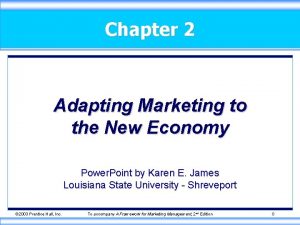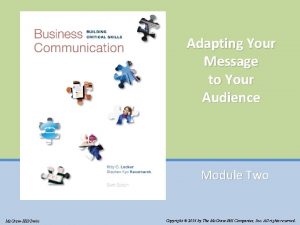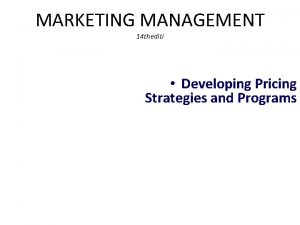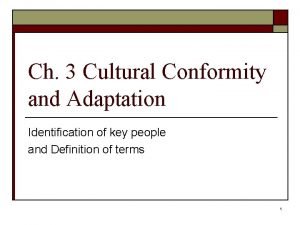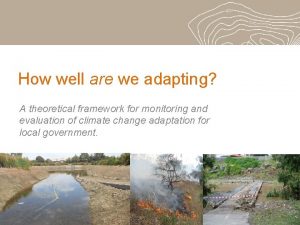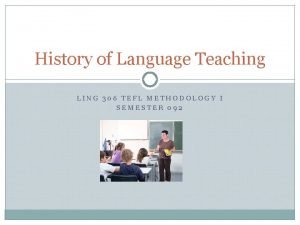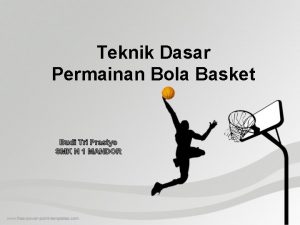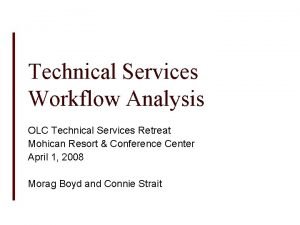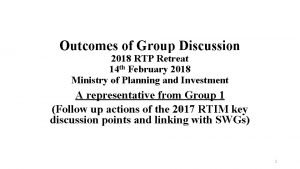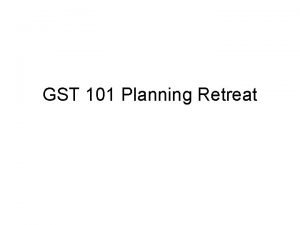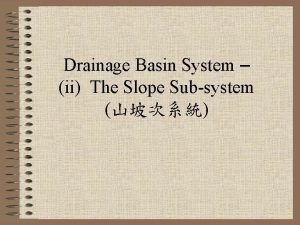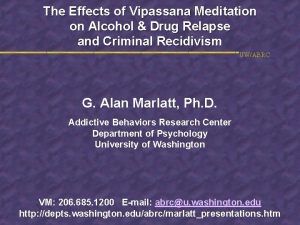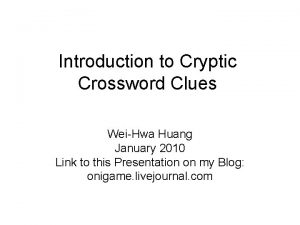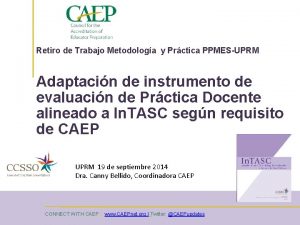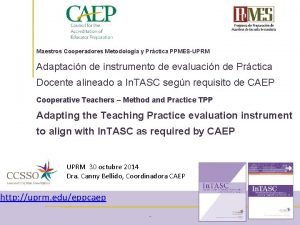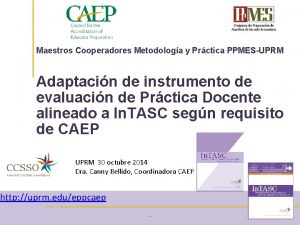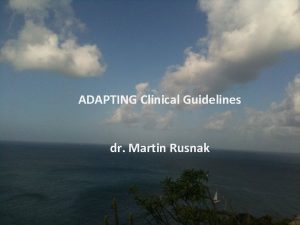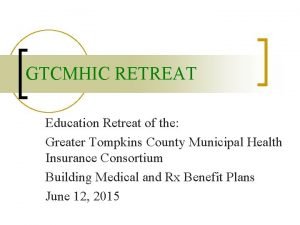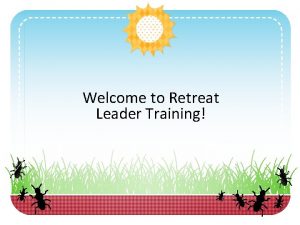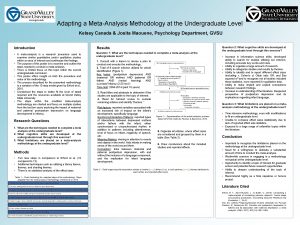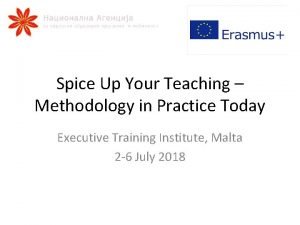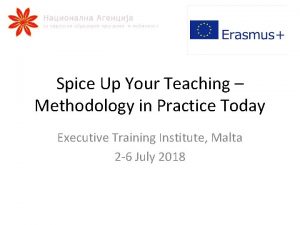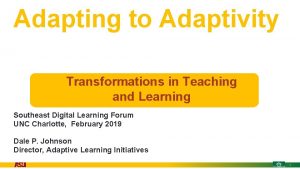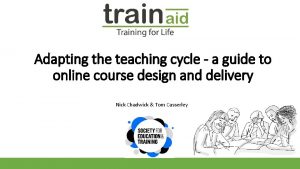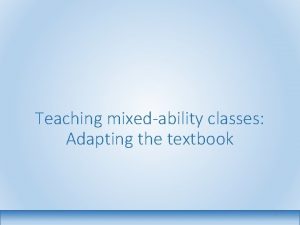PPMESUPRM Methodology Practice Working Retreat Adapting the Teaching



























- Slides: 27

PPMES-UPRM Methodology & Practice Working Retreat Adapting the Teaching Practice evaluation instrument to align with In. TASC as required by CAEP UPRM September 19, 2014 Dra. Canny Bellido, CAEP Coordinator CONNECT WITH CAEP | www. CAEPnet. org | Twitter: @CAEPupdates

Today’s Working Objectives: • Adapt the teaching practice evaluation instrument to align with In. TASC standards to meet CAEP accreditation requirements

Agenda ü 1: 00 – 1: 30 pm Introduction and instructions on adapting the teaching practice evaluation instrument to align with In. TASC as required by CAEP ü 1: 30 – 3: 00 pm Fill out the Qualtrics sheet (Utah Valley Observation Rubric) and create or modify the items assigned to your group ü 2: 30 pm Coffee break ü 3: 00 – 4: 00 pm Present work by groups by In. TASC Standard ü 4: 00 pm Plan next steps


5

Key Changes from the 1992 Standards to 2011 • Developmental Continuum: Standards no longer just for beginning teachers but ALL teachers. – INTASC becomes In. TASC (Interstate Teacher Assessment and Support Consortium) • A Focus on 21 st Century Knowledge and Skills: Problem solving, curiosity, creativity, innovation, communication, interpersonal skills, the ability to synthesize across disciplines, global literacy, ethics, and technological expertise. • Personalized Learning for Diverse Learners: Teachers need knowledge and skills to customize learning for learners with a range of individual differences.

Key Changes from the 1992 Standards to 2011 • Increased Emphasis on Assessment Literacy: Teachers need to have greater knowledge and skill around how to develop a range of assessments and how to use assessment data to improve instruction and support learner success. • A Collaborative Professional Culture: Teaching is no longer a private act. • New Leadership Roles for Teachers and Administrators: A shift in leadership from teachers working autonomously in their classrooms to administrators, teachers, and others sharing leadership roles and responsibilities for student learning.

For each and every standard Performance Standards 1 to 10 Critical Dispositions Essential Knowledge

Groupings of Standards


Feedback of UVU Rubric on Qualtrics


CAEP Recommendations for teaching evaluation rubrics • Do not exceed 25 to 30 total items in the rubric (the UVU rubric has only 24 in total) • Always show clear alignment with INTASC Standard phrasing • Use criteria that show continuous growth and explain how to improve. Example: Emerging / Developing / Proficient / Accomplished Developing / Competent / Exemplary Not evident/ Needs substantial improvement/ Needs some improvement/ Meets expectations / Exceeds expectations

Agenda ü 1: 30 – 3: 00 pm Fill out the Qualtrics sheet and créate or modify ítems in the part assigned to your group ü 3: 00 – 4: 00 pm Present group’s work ü 4: 00 pm Plan next steps Designate a different person for each of the following tasks: – Enter a summary of group in Qualtrics – Note ítem modifications or new ítems needed – Present results to all the groups

Group Work Until 3: 00 pm http: //www. online-stopwatch. com/countdown-clock/full-screen/

Presentations of Gropus by In. TASC Standard • Each group has 15 minutes to present

The Learner and Learning Standard #1: Learner Development • The teacher understands how learners grow and develop, recognizing that patterns of learning and development vary individually within and across the cognitive, linguistic, social, emotional, and physical areas, and designs and implements developmentally appropriate and challenging learning experiences.

The Learner and Learning Standard #2: Learning Differences • The teacher uses understanding of individual differences and diverse cultures and communities to ensure inclusive learning environments that enable each learner to meet high standards.

The Learner and Learning Standard #3: Learning Environments • The teacher works with others to create environments that support individual and collaborative learning, and that encourage positive social interaction, active engagement in learning, and self motivation.

Content Knowledge Standard #4: Content Knowledge • The teacher understands the central concepts, tools of inquiry, and structures of the discipline(s) he or she teaches and creates learning experiences that make these aspects of the discipline accessible and meaningful for learners to assure mastery of the content.

Content Knowledge Standard #5: Application of Content • The teacher understands how to connect concepts and use differing perspectives to engage learners in critical thinking, creativity, and collaborative problem solving related to authentic local and global issues.

Instructional Practice Standard #6: Assessment • The teacher understands and uses multiple methods of assessment to engage learners in their own growth, to monitor learner progress, and to guide the teacher’s and learner’s decision making.

Instructional Practice Standard #7: Planning for Instruction • The teacher plans instruction that supports every student in meeting rigorous learning goals by drawing upon knowledge of content areas, curriculum, cross-disciplinary skills, and pedagogy, as well as knowledge of learners and the community context.

Instructional Practice Standard #8: Instructional Strategies • The teacher understands and uses a variety of instructional strategies to encourage learners to develop deep understanding of content areas and their connections, and to build skills to apply knowledge in meaningful ways.

Professional Responsibility Standard #9: Professional Learning and Ethical Practice • The teacher engages in ongoing professional learning and uses evidence to continually evaluate his/her practice, particularly the effects of his/her choices and actions on others (learners, families, other professionals, and the community), and adapts practice to meet the needs of each learner.

Professional Responsibility Standard #10: Leadership and Collaboration • The teacher seeks appropriate leadership roles and opportunities to take responsibility for student learning, to collaborate with learners, families, colleagues, other school professionals, and community members to ensure learner growth, and to advance the profession.

Next Steps Group recommendations for proceeding with the Student Teaching Classroom Observation Instrument.
 Differentiate adopting materials and adapting materials
Differentiate adopting materials and adapting materials How well are we adapting
How well are we adapting How to adapt marketing to the new economy
How to adapt marketing to the new economy Adapting the message to your audience
Adapting the message to your audience Adapting to challenges of the micro environment
Adapting to challenges of the micro environment Adapting the price
Adapting the price The process of adapting borrowed cultural traits.
The process of adapting borrowed cultural traits. Adapting the price
Adapting the price Audience analysis example
Audience analysis example How well are we adapting
How well are we adapting Adapting curriculum to bridge equity gaps
Adapting curriculum to bridge equity gaps Working hard vs working smart
Working hard vs working smart Cold working advantages
Cold working advantages Hot working and cold working difference
Hot working and cold working difference Differentiate between hot working and cold working
Differentiate between hot working and cold working Pembentukan plat pada pengerjaan panas
Pembentukan plat pada pengerjaan panas History of language teaching methodology
History of language teaching methodology Bermain lempar pantul bola sedikitnya membutuhkan
Bermain lempar pantul bola sedikitnya membutuhkan Olc technical services retreat
Olc technical services retreat Retreat at rtp
Retreat at rtp Gst 101 form
Gst 101 form Free face slope
Free face slope Vipassana 10 day silent retreat substance abuse
Vipassana 10 day silent retreat substance abuse Physician burnout retreat
Physician burnout retreat Split like a hoof crossword
Split like a hoof crossword Synthesis plural
Synthesis plural Covetousness
Covetousness Dhanyawad slide
Dhanyawad slide


